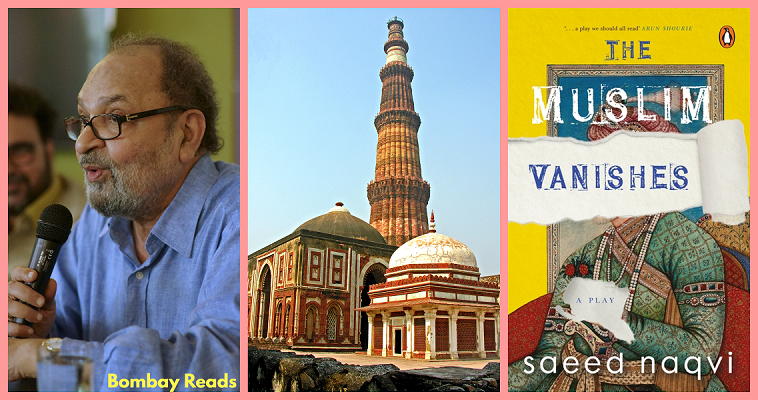The Muslim Vanishes is probably the most important political fiction since Jinnah: India, Partition, Independence. Saeed Naqvi brilliantly captures the underlying crux of the growing Hindutva extremism in the country. While the author presents more than a few controversial viewpoints, the primary objective of this unique play is right on the button. Let’s explore The Muslim Vanishes, a play that’s ruffled many feathers (understandably so).
Summary of The Muslim Vanishes
Though the play addresses issues of national and international significance, The Muslim Vanishes has a simple yet impactful storyline. The entire Muslim population of India, the second largest in the world, vanishes from the country. There’s no trace whatsoever, and the entire country runs into chaos.
The news of the Muslims vanishing from the country spreads like a forest fire. Following the initial shock, the upper caste or the Savarnas plan to take over the properties and businesses left by the Muslims. However, the backward classes or the Avaranas have already occupied much of the properties and business, igniting a scary feud between the two groups.
The Savarnas are agitated and anxious over the possibility of the Dalits rising to powerful positions. Soon, the upper caste, who oppressed the Muslims and used them to polarise the Hindus, now wanted vanished Muslims to return. They want the elections to be postponed until the Muslims return, while the Avarnas want an immediate election.
The tussle between the Savarnas and the Avarnas reaches the Supreme Court. Taking an unusual step to solving a unique crisis, the Supreme Court commissions a jury, members of which are all the great historical legends. The jury includes the likes of Amir Khusro, Jyotirao Phule, Maulana Hasrat Mohani, Munshi Channulal Dilgeer, Tulsidas, and Abdul Rahim Khan-e-Khana.
Along with the Muslims has gone the famous Qutub Minar of Delhi, paintings, poems, and other artworks of Muslim artists. Saeed Naqvi symbolically sketches the contribution of Muslims to the culture and historical heritage of India.
Breaking the Hindu vs Muslim Polarization Myth
The secular fabric of India has been burning consistently since the demolition of the Babri Masjid in the early 90s. Since then, authors like former I.G. of Maharashtra Police, S.M. Mushrif, Prof. Shamsul Islam, and veteran journo A.G. Noorani have written various books exposing the upper caste Hindu oppressing the Muslims and Dalits. However, all those books are gruesome accounts of real-life incidents, making them emotionally challenging to read.
That’s where Saeed Naqvi’s The Muslim Vanishes shines. It is one of the most entertaining and intriguing books on the subject to come out in a long time. The book’s hilarious on several occasions, though it gets dark almost instantly. The way Naqvi builds the tension between the Savarnas and the Avarnas exposes the real insecurities of the country’s ruling elite.
Naqvi argues that regardless of how much the Savarnas discredit or ridicule them, Muslims are necessary for their dominance. Once the Muslims vanished, the real power struggle emerged between the upper caste Hindus and the Dalits. The new political dynamics compel the now vulnerable ruling elite to do something unthinkable: THEY WANT MUSLIMS TO COME BACK!
Savarnas vs Avarnas – The Underlying Struggle
After the Muslims vanished, Dalits accounted for over 70% of the population, leaving the ruling upper class anxious. The issues that the ruling elite used to dehumanize Muslims and polarize the Hindus, cow slaughter, growing Muslim population, love jihad, etc., have no relevance now. They have no agenda that can save their powerful berths and fear that Dalits will now start eying upward mobility.
On the other hand, Dalits have started to realize that the upper caste Hindus don’t want them to move upward. They realized that Muslims were not their enemies but those who’ve kept them away from power. They now want an equal share in “nation-building,” something they’ve forgotten for years hating and fighting Muslims.
In reality, this is what’s happened for centuries. Take the assassinations of Dalit activists like Govind Pansare, Narendra Dhabolkar, and M.M. Kalburgi. They indicate how the far-right, dominated by the Savarnas, doesn’t tolerate any socio-political reform within the backward communities. Likewise, the suicides of Rohit Vemula and Payal Tadvi expose the harassment Dalits face from the upper caste.
My Problem with The Muslim Vanishes
While The Muslim Vanishes highlights the genuine reasons behind the plight of Muslims, it also does grave injustice to Muslim history. Saeed Naqvi presents an apologetic view of the history of Muslims in India. In fact, he portrays Muslim saints like Khwaja Amir Khusro and Shah Abdul Razzaq of Bansa as perennialists, which is a blatant fabrication.
The author tries to paint an apologetic view of Indian Muslims, in which “Indian Islam” is different from the Arabian one. He argues that famous Muslims adopted the “Hindu Culture,” devoting themselves to Indian deities. While this may be true for a few individuals, painting all Indian Muslims with the same brush is a crime.
In one of the scenes in the last act, the author says that Muslim clergymen made Arabic the official language. He also says that C.N. Ahmed Maulvi “Indianized” the Holy Qur’an by translating it into Malayalam. Such statements are absolutely irresponsible and are a result of ignorance.
The author must know that the first Tafseer or exegesis of the Qur’an in India was written by Faqih Ali Mahaimi more than 600 years ago. Likewise, the Qur’an has been translated into hundreds of languages around the world. Does this mean that there are hundreds of versions of Islam? And as far as the clergy declaring Arabic as the language of Islam, the author fails to recognize that Qur’an came to the Arabs, who spoke Arabic. However, there are enough books in global languages like Urdu, Persian, Malayalam, Bangla, English, etc., for a common man to understand Islam.
Evidence for Everything but Claims About Muslim Saints
Though the author references most claims and facts presented in The Muslim Vanishes, he conveniently skips them while accusing Muslim saints of being perennialists. None of the religious figures mentioned in the book, including Khwaja Amir Khusro, Mawlana Hasrat Mohani, or Shah Abul Razzaq of Bansa, ever revered or adhered to any religion other than Islam.
The concept of giving equal respect to all religions is known as ‘Sulh e Kul,’ something that Islam openly prohibits. In fact, it is against the basic tenets of the religion. The author fails to associate the centuries of harmony between Hindus and Muslims with the idea of ‘Sulh e Kul.’ In fact, the Islamic principle of peaceful co-existence is responsible for it.
Peaceful co-existence helped Muslims live in communal harmony with other religious communities in India and around the world. Be it the Christians in Syria or Yazidis in Iraq, minorities never faced threats in Muslim lands. That’s what the author misses completely, making it a missed opportunity for discussing a topic as crucial as peaceful co-existence. Until the Hindus and Muslims agree to let the other live a dignified life, clashes will continue to grow, eventually tearing the country apart.
Final thoughts on The Muslim Vanishes
Saeed Naqvi has an unparalleled imagination, making The Muslim Vanishes one of the most important books for our generation. Amid the growing communal tension in the country, this unique ‘play’ could well be the eye-opener folks need. Naqvi gives a realistic idea of the mindset of people who engage with or implant discords between Hindus and Muslims.
This is also a must-read for literature buffs exploring original Indian literary works in English. Differences aside, Naqvi is undoubtedly among the modern era’s most well-formed and creative Indian minds. This unique play clearly reflects his literary finesse and experience as a journalist.
About the Author – Saeed Naqvi
Saeed Naqvi is a renowned Indian journalist and political commentator. He has interviewed prominent world leaders in his illustrious career spanning over five decades. Naqvi has worked with some of the most prestigious news media houses, including BBC News, The Guardian, Washington Post, The Indian Express, and Outlook Magazine. He is also known for his hard-hitting, ground-breaking books such as Reflections of an Indian Muslim (1993), The Last Brahmin Prime Minister (1996), and Being the Other: Muslim in India (2016).
Liked this review? Check out other exciting book reviews here. You can also read insightful blogs about books here.

Noman Shaikh is the co-founder and editor-in-chief of Bombay Reads. He grew up in Mumbai, a city he loves more than any other, and currently works as a content consultant. His expertise lies in creating high-quality academic and marketing content in the form of blogs, articles, op-eds, etc. Noman has worked with reputed brands, including Economic Times (through Spiral Media), Coinbase (through MattsenKumar), AdEngage, Della Group, GBIM Technologies, VAP Group, etc. For his published portfolio, click here. Contact Noman on noman@bombayreads for engagement.

